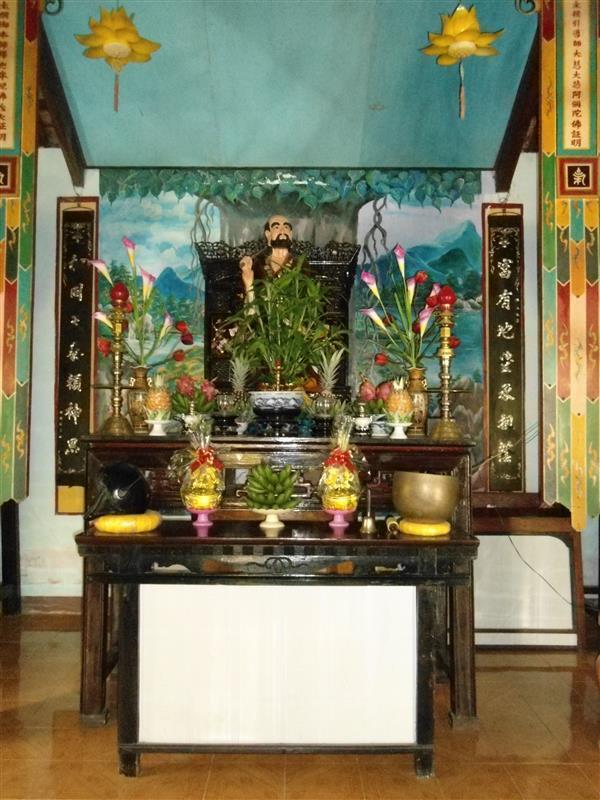Description
Kim Long Pagoda is located in Phu Hoa village, Ninh Quang commune, Ninh Hoa town, Khanh Hoa province.
According to oral tradition and the spirit of the patriarch (Hue Phap)[1] who is worshiping at the monument, it can be estimated that Kim Long Pagoda is dated to the early 19th century. In the beginning, the pagoda was a small house with earthen walls and thatched roofs and was named Kim Long Tu.


Altar of the Dalai Lama
Over a period of existence and development, Kim Long Pagoda has affirmed its role in village life, that is to nurture and give wings to many strata of people in Phu Hoa village to live in a good direction, cultivate the mind and nurture the soul. according to Buddhist teachings. The temple has oriented to the core values of spiritual life, directing people to the right view to understand the impermanent life in the human realm. In order to become the center of religious activities of Phu Hoa village as it is today, the abbots of Kim Long Pagoda and the local revolutionary elders have constantly set an example and directed the villagers to the values of the village. good cultural values, in accordance with local customs and human ethics. In recognition of these contributions, King Tu Duc in the 20th year (1868) gave the villagers a signboard with four words: "Good customs worthy of being handed down" (Good custom worth handing down), solemnly hung in the village. Buddha hall of Kim Long pagoda.
Over a long period of existence, the Kim Long temple documents record the people at the forefront of the pole, including the following names:
- The painting team - Most Venerable Hue Phap (Huy An Hai -1801);
- Zen Master Doan Gia Tho;
- Mr. Master of Universal Origin (1905);
- Mr. Thanh Chanh Phuoc Tuong (1905-1922);
- Mr. Trung Thong Nhan Due (1923-1940);
- Mr. Thi Lac Hung Tu (1940-1945)[2];
- Mr. Quang Quy Chanh Vinh (1945-1958);
- Mr. Nhu Huong (1958-1961);
- Mr. Dharma Body (1967-1968);
- Mr. Thien Cong (1969-1972);
- Mr. Bao Hien (1973-1974);
- Mr. Thien Cong (1975-1987);
- Temple without abbot: (1987-1998);
- Likes female Minh Nhan: July 1998 to present.
Kim Long Pagoda was built to worship Thich Ca, Phap Phap, Luu Bei, Chau Xuong, Quang Binh, Quan Truong, Dat Ma, Quan Am, Dai Tang, Truong Phi and incense.
Over 2 centuries of existence, Kim Long Pagoda has undergone many renovations and embellishments as follows: 1938, 1974, 2003.
Kim Long Pagoda was built on a campus with a total area of 4,190m2, the facade facing the West. From the outside to the inside, the pagoda has an overall layout including architectural components such as: Tam Quan, Quan Am Bodhisattva, main hall, ancestral house, east house, west house and side gate. The decorations and decorations on the temple architecture are all directed to Buddhist teachings such as the wheel of Dharma, the lotus... the ancestral house still retains the relatively intact wooden frame structure with 4 columns (perimeter). 75cm), because the roof is truss-type structure.
Main hall of Kim Long Temple
During the French colonial period, Mr. Thong Nhan Due and Mr. Thi Lac Hung Tu were monks who participated in revolutionary activities. During the resistance war against the French colonialists and the American imperialists, Kim Long Pagoda was the basis of revolutionary activities in the Nam Ninh Hoa region; is a place of communication and meeting of mass organizations and a place to strengthen the revolutionary base throughout the villages in the region[3]; the pagoda was the gathering place of Vo Quoc Thu Company in the period of 1945-1954 and the place where the National Assembly election was held in 1946; It is a place for local soldiers to study and prepare to gather in the North.
Like other pagodas, Kim Long Pagoda also has 04 main festivals taking place in the year: January 15 of lunar calendar, April 15 of lunar calendar, July 15 of lunar calendar, and July 27 of lunar calendar. In 1942, the pagoda organized the Great Precepts for Buddhist monks in the whole region. In addition, on the 1st and the full moon of every month, the pagoda also organizes a ceremony to worship the squirrel and hope.
On November 20, 2012, Khanh Hoa Provincial People's Committee issued Decision No. 2891/QD-UBND ranking Kim Long pagoda relic as a provincial historical-cultural relic.
Tran Thi Thanh Loan
[1] Most Venerable Hue Phap (Hui An Hai) belonged to the 39th generation of the Lam Te Zen sect, which existed between 1770-1820.
[2] The most flourishing period of Kim Long Pagoda was in 1942.
[3] Executive Committee of Ninh Quang Commune Party Committee, Revolutionary History of Ninh Quang Commune (1930–2010), Ninh Quang, June 2011, page 36.